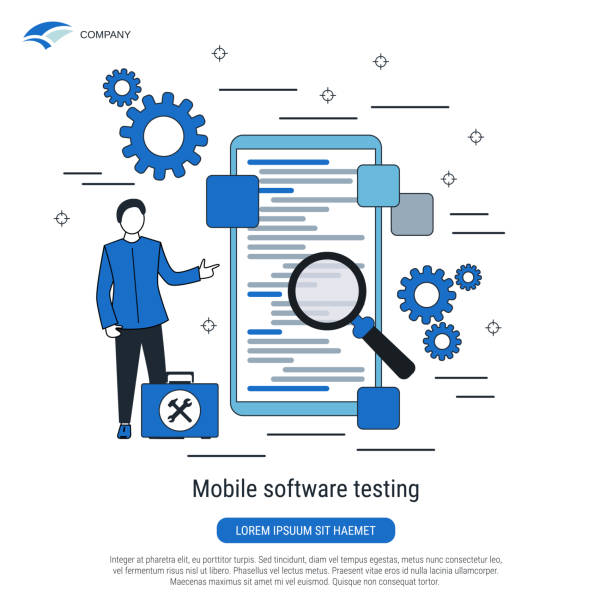The Importance of Fast Website Design in the Digital Age

In today’s fast-paced world, where every second holds high value, website loading speed has become one of the most crucial factors for online success.
#User_Experience and #Search_Engine_Optimization (SEO) are two main pillars that are heavily influenced by site speed.
When talking about fast website design, it actually refers to optimizing all technical and content aspects of a website to deliver the best performance in the shortest possible time.
Studies have shown that every second of delay in page loading can severely decrease conversion rates and even lead to an increase in Bounce Rate.
Today’s users are more impatient than ever and expect websites to load immediately.
This issue is not only crucial for user satisfaction, but search engines like Google also place special importance on site speed.
Google has explicitly stated that page load speed is one of the ranking factors in search results.
A website that is implemented with fast website design and optimization not only provides a better user experience (UX) but also has a higher chance of achieving higher rankings in search results.
This explains why every business, from small to large, should focus on optimizing their website speed.
Ignoring this issue can lead to losing potential customers and decreased revenue.
This is an explanatory view of why website speed is vital in this era.
In fact, the concept of “fast website design” goes beyond a mere technical discussion; it is a comprehensive strategy for online success.
If your site is slow, all your efforts in content marketing, SEO, and advertising may be futile.
Users will simply turn to competitors who have faster websites.
This is an essential investment for retaining and attracting an audience and directly impacts your business’s credibility and profitability.
For this reason, a deep understanding of the factors affecting speed and how to optimize them is of great importance.
Did you know that 94% of a company’s first impression is related to its website design?
Rasaweb, by offering professional corporate website design services, helps you create the best first impression.
✅ Create a professional and trustworthy image for your brand
✅ Easier attraction of potential customers and improvement of online standing
⚡ Get a free consultation for corporate website design
Main Factors Affecting Website Speed

To achieve fast website design, we must first identify the main factors that affect website loading speed.
#Hosting, #Image_Size, and #Code_Optimization are three fundamental pillars that directly impact your site’s speed.
Choosing a suitable hosting provider, with powerful and optimized servers, is the first important step.
Cheap shared hosting might be tempting at first, but it often has limited resources, leading to reduced speed.
VPS, dedicated, or cloud hosting usually offer better performance, especially for websites with high traffic or heavy content.
The second important factor is the size and number of images and other media files.
High-quality and unoptimized images can create a heavy load on the server and the user’s bandwidth.
Using appropriate formats (like WebP), compressing images without noticeable quality loss, and implementing Lazy Loading can significantly contribute to increasing site speed.
This section analytically examines each of these factors in more detail.
The third factor is the optimization of HTML, CSS, and JavaScript codes.
Disordered, uncompressed, or erroneous codes can severely increase page loading time.
Furthermore, excessive use of plugins and heavy themes can also harm website speed.
Each additional plugin or script creates more HTTP requests and can consume server resources.
Therefore, careful review and removal of unnecessary plugins or replacing them with lighter solutions play a key role in achieving fast website design.
Additionally, using Content Delivery Networks (CDNs) to cache and deliver content from the closest server to the user can make a significant difference in speed, especially for international audiences.
These factors interact with each other, and optimizing each one individually is not enough; a comprehensive approach to speed optimization is essential.
Tools and Methods for Website Speed Assessment

To know how fast our website is and what its weaknesses are, we need precise speed assessment tools.
#Speed_Analysis, #Free_Tools, and #Performance_Report are three important aspects of this process.
Tools like Google PageSpeed Insights, GTmetrix, and Pingdom Tools are excellent resources for obtaining performance data and optimization recommendations.
These tools measure metrics such as Time to First Byte (TTFB), Time to Interactive (TTI), and Speed Index, and provide a score for overall site performance.
More important than the score are the recommendations these tools offer for improving speed, such as image compression, cache activation, or eliminating render-blocking resources.
Google PageSpeed Insights not only assesses speed for desktop and mobile but also measures Google’s Core Web Vitals (LCP, FID, CLS), which are crucial for SEO.
GTmetrix and Pingdom Tools also provide more details about the loading time of each HTTP request, file sizes, and Waterfall structure, which are very useful for guidance and more precise analyses.
For example, you can see which scripts or images take the longest to load.
By using these tools, you can periodically monitor your site’s performance and ensure that your fast website design is in the best possible state.
In the following, a comparative table of these tools and their main features is provided to help you choose the appropriate tool:
| Tool | Main Focus | Key Features | Strengths |
|---|---|---|---|
| Google PageSpeed Insights | User Experience and SEO | Core Web Vitals, Google recommendations, Real User Monitoring (CrUX) data | Integration with Google ecosystem, focus on real UX |
| GTmetrix | Overall Performance and Technical Details | Waterfall Chart, YSlow and PageSpeed reports, device simulation | Extensive details for developers, visual loading display |
| Pingdom Tools | Load Time and Requests | Checks from multiple geographic regions, performance history, component load time analysis | Ease of use, checks from various locations worldwide |
Regular use of these tools helps you continuously take action for website speed optimization and provide a better experience for users.
This is a critical component on the path to achieving a successful fast website design.
Optimizing Images and Media for Fast Website Design

One of the biggest factors slowing down websites is the large size of images and media files.
#Image_Compression, #Lazy_Loading, and #WebP_Format are three key strategies to solve this problem and achieve a fast website design.
Many websites load images with dimensions and quality far exceeding what is needed, leading to an unnecessary increase in page size.
This is particularly problematic for users on mobile internet.
The first step is to use image compression tools.
These tools can reduce file size without a noticeable loss in visual quality.
Compression can be either Lossy (quality reduction) or Lossless (no quality reduction).
Choosing the right image format is also crucial.
JPEG formats are suitable for photos, PNG for images with transparency, and SVG for vectors.
However, the WebP format, developed by Google, offers better compression while maintaining similar quality and is increasingly supported by browsers.
Converting images to WebP format can significantly reduce page size and help increase site speed.
This approach is a specialized look at media management on a website.
In addition to compression and format, implementing Lazy Loading is also vital.
With Lazy Loading, images and other media elements are only loaded when the user scrolls to the relevant section of the page and they become visible in the user’s viewport.
This prevents all images from loading simultaneously during the initial visit, making the page ready for display much faster.
Furthermore, specifying definite dimensions for images (width and height) in the HTML code prevents Layout Shift and provides a better user experience.
These combined actions ensure that your images are optimized and efficient, which is a fundamental element in fast and responsive website design.
Does your current corporate website not reflect your brand’s credibility and strength as it should? Rasaweb solves this challenge for you with professional corporate website design.
✅ Increase visitor credibility and trust
✅ Targeted attraction of more customers
⚡ Click for a free consultation!
Clean and Optimized Coding for High Speed

The quality and structure of a website’s code play a significant role in its loading speed.
#Code_Minification, #Asynchronous_Loading, and #Render_Blocking_Resources are three key concepts in code optimization for achieving a fast website design.
Clean and optimized coding means removing extra bytes and ensuring that scripts and styles are loaded in a way that creates the least delay in page rendering.
Minification is the process of removing spaces, comments, and extra characters from HTML, CSS, and JavaScript files.
This reduces file sizes and speeds up loading time.
Many tools exist to automate this process, which can automatically compress your code.
Another important issue is “render-blocking” resources; meaning CSS and JavaScript files whose loading stops the page from rendering.
To solve this, CSS files should be placed in the <head> section and JavaScript files at the end of the <body>.
Also, using async and defer attributes in <script> tags is very effective for asynchronous loading of JavaScript.async allows the script to be loaded and executed simultaneously with HTML parsing, while defer executes the script after the HTML has been fully parsed.
This is an educational approach to optimizing web codes.
Furthermore, the use of web fonts can also affect speed.
Choosing optimized fonts and loading only their necessary subsets, rather than the entire font family, can help reduce loading time.
Also, reducing HTTP requests by combining CSS and JavaScript files (if possible and without causing caching issues) can improve performance.
Avoid using heavy JavaScript frameworks and libraries where only a small portion of them is utilized.
Every line of code you add should have a functional justification to maintain website speed.
These techniques collectively contribute to a fast and efficient website design.
The Role of Hosting and CDN in Fast Website Design

The web hosting infrastructure and how content is delivered to users play a vital role in achieving a fast website design.
#Content_Delivery_Network (CDN), #Fast_Server, and #Host_Location are three fundamental factors in this regard.
The type of hosting you choose directly impacts your site’s loading speed.
Shared hosting is suitable for small, low-traffic websites, but for larger projects or growing sites, it may not provide sufficient resources, leading to slowness.
In these cases, Cloud Hosting, Virtual Private Servers (VPS), or dedicated servers are better options, offering more control, dedicated resources, and consequently, higher speed.
The geographical location of the server is also an important factor.
If most of your users are in Iran, choosing hosting with servers within the country or close to it can significantly reduce latency.
The shorter the physical distance between the user and the server, the faster the information is transmitted.
This is an explanatory section about website speed infrastructure.
However, for websites with a global audience, using a CDN (Content Delivery Network) is essential.
A CDN is a network of servers distributed across different parts of the world that store cached versions of your website’s static content (such as images, CSS, and JS).
When a user from a specific geographical area requests content, the CDN delivers the content from the server closest to that user.
This significantly reduces loading time and also lessens the load on your main server.
Cloudflare, Akamai, and Amazon CloudFront are among the most popular CDN providers.
Combining powerful and optimized hosting with an effective CDN can be a huge step towards achieving fast website design and responsive design.
This investment in infrastructure will directly and positively impact your user experience and SEO ranking, ensuring your website’s speed optimization.
Caching and Data Compression for Greater Efficiency

Caching and data compression are two vital techniques for achieving fast website design and optimizing website performance.
#Browser_Caching, #Gzip_Compression, and #Performance_Enhancement are among the key concepts in this area.
Caching means storing a copy of website content in a temporary location so that on subsequent visits, there is no need to reload from the main server.
This significantly reduces loading time for returning visitors and also lessens the load on the server.
There are two main types of caching: browser-side caching and server-side caching.
Browser-side caching allows the user’s browser to store static files such as images, CSS, and JavaScript in its local memory.
By doing this, on subsequent visits to the same site, the browser loads these files from its cache instead of requesting them again from the server.
This process is controlled by HTTP headers like “Expires” and “Cache-Control”.
Activating this type of caching is essential for fast website design.
Server-side caching (such as Page Caching, Object Caching, and Database Caching) is more complex and directly impacts server performance.
This type of caching stores pre-generated versions of pages or database query results, eliminating the need for re-processing with each request.
This is a specialized look at data management.
Alongside caching, data compression is also of great importance.
Gzip is one of the most popular compression methods that can reduce the size of HTML, CSS, and JavaScript files by up to 70%.
When the browser makes a request to the server, if Gzip is enabled, the server sends the compressed version of the file and the browser decompresses it.
This significantly reduces bandwidth consumption and data transfer time, leading to a significant increase in website speed.
Proper implementation of caching and Gzip compression can substantially contribute to fast and efficient website design and improve user experience.
In the following, a table explaining the types of caching and their uses is provided:
| Caching Type | Execution Location | Functionality | Main Advantage |
|---|---|---|---|
| Browser Cache | User’s device | Stores static files (images, CSS, JS) for subsequent visits | Increased speed for returning visitors, reduced server requests |
| Page Cache | Server | Stores full HTML versions of pages, eliminates need for reprocessing | Reduced server load, improved TTFB (Time to First Byte) |
| Object Cache | Server | Stores database query results and complex computations | Increased speed for dynamic applications, reduced database pressure |
| CDN Caching | Global network of servers | Distributes static content from the closest server to the user | Increased speed for users in different geographical regions |
Common Challenges and Problems in Speed Optimization

Despite all available solutions for fast website design, the optimization path is not always smooth, and numerous challenges and problems can arise.
#Speed_Issues, #Excessive_Plugins, and #External_Dependencies are among the common obstacles that developers and website administrators contend with.
One of the most common problems is the excessive use of plugins and heavy themes.
Every plugin or theme added to a site brings new CSS, JavaScript codes, and HTTP requests, which can significantly increase page load time.
This issue is particularly prevalent in content management systems like WordPress.
Another challenge is the reliance on external scripts and APIs.
Google Analytics tracking codes, social media buttons, web fonts, and embedded videos from platforms like YouTube can all lead to website slowdowns, especially if external servers do not respond adequately.
This is a question-raising content on how to maintain speed without sacrificing functionality.
Additionally, outdated and unoptimized code, uncompressed images, and the lack of caching and CDN use are other problems we constantly face.
Even with analysis tools, pinpointing the exact root of a site’s slowness is sometimes difficult, as various factors can play a role.
To overcome these challenges, a comprehensive approach and continuous monitoring are needed.
Regularly reviewing and removing unnecessary plugins, optimizing codes and images, using powerful hosting and CDN, and implementing caching are all steps towards faster website design.
In some cases, it may even be necessary to rewrite parts of the code or change the theme.
Investing in education and consulting with speed optimization specialists can also be helpful.
Although these problems can be discouraging, with the right strategy and persistence, desired website speed can be achieved.
Did you know that 94% of a company’s first impression is related to its website design?
Rasaweb, by offering professional corporate website design services, helps you create the best first impression.
✅ Create a professional and trustworthy image for your brand
✅ Easier attraction of potential customers and improvement of online standing
⚡ Get a free consultation for corporate website design
The Impact of Site Speed on SEO Ranking and User Experience

In today’s competitive web world, site speed is not just a luxury feature but an absolute necessity for SEO success and providing a superior user experience (UX).
#Ranking_Factors, #Page_Experience, and #Core_Web_Vitals are all directly related to fast website design.
Google has explicitly stated that page speed and overall user experience are important factors in its ranking algorithm.
This means that if your website is slow, regardless of the quality of your content, you may achieve a lower ranking in search results.
Google’s Core Web Vitals metrics (which include Largest Contentful Paint – LCP, First Input Delay – FID, and Cumulative Layout Shift – CLS) have been specifically introduced to measure user experience from the perspective of speed, interactivity, and visual stability.
LCP measures the loading time of the largest content element on the page, FID evaluates the site’s responsiveness to the user’s first interaction (such as a click), and CLS examines the visual stability of the page.
Good performance in these metrics is crucial for SEO and is directly tied to the concept of fast website design.
This is an in-depth analysis of the importance of speed for web rankings.
From a user’s perspective, a slow website provides an unpleasant experience.
Users are impatient and tend to leave sites that take a long time to load.
This leads to an increased Bounce Rate and reduced time spent on the site, both of which are negative signals for search engines.
In contrast, a fast website keeps users satisfied, increases their engagement, and makes it more likely for visitors to convert into customers.
This not only helps improve SEO but also directly impacts your business’s Conversion Rate and revenue.
Investing in fast website design is an investment in your future and online success.
The Future of Fast Website Design and Emerging Trends

The world of the web is constantly evolving, and with the emergence of new technologies, the concept of fast website design is also changing.
#Progressive_Web_Apps, #Accelerated_Mobile_Pages, and #Web_3 are among the emerging trends that are shaping the future of web speed and performance.
Progressive Web Apps (PWAs) are one of the most important of these trends.
PWAs combine the best features of websites and mobile applications; they load quickly, even work offline, and can be installed as a native app on the phone’s home screen.
These capabilities significantly improve user experience and contribute to increased speed and accessibility.
Accelerated Mobile Pages (AMP) is another project from Google aimed at delivering web content on mobile devices at incredibly high speeds.
AMP pages are optimized using a limited subset of HTML, CSS, and JavaScript and leverage Google’s powerful caching.
Although AMP has been controversial, it can be very useful for news and content sites that require instant loading on mobile.
This trend is news-worthy and indicates that Google continues to prioritize mobile speed.
Furthermore, with advancements in HTTP/3 (the next generation of the HTTP protocol) and the use of the QUIC protocol, web communications are expected to become faster and more reliable.
In addition, the use of Artificial Intelligence (AI) and Machine Learning (ML) in optimizing website performance is increasing.
AI-powered tools can automatically compress images, optimize code, and even fine-tune caching settings based on traffic patterns.
Serverless architectures and Edge Computing are also moving towards processing data at the closest point to the user to minimize latency.
These advanced trends promise a future where fast website design will become a global standard, and the online experience for all users will continuously improve.
Keeping pace with these changes is essential for any webmaster seeking high performance.
Frequently Asked Questions
| Row | Question | Answer |
|---|---|---|
| 1 | What is fast website design? | Fast website design refers to a process where a functional and optimized website is launched in the shortest possible time, without sacrificing quality or efficiency. |
| 2 | What factors are effective in fast website design? | Using ready-made Content Management Systems (CMS) like WordPress, optimized ready-made templates, visual design tools, designer experience, and effective client communication. |
| 3 | Does fast website design always mean reduced quality? | No, with proper planning, using optimized tools, and standard techniques, a high-quality website can be designed in a short time. |
| 4 | What types of websites are more suitable for fast design? | Small corporate websites, blogs, online resumes, landing pages, and online stores with limited products. |
| 5 | What is the role of CMSs (like WordPress) in fast design? | CMSs significantly accelerate the design and development process by providing templates, plugins, and an easy-to-use administration panel. |
| 6 | Does fast website design cost less? | Usually, yes. Due to reduced designer working time and the use of ready-made resources, costs can be significantly reduced. |
| 7 | What information is needed from the client for fast design? | Contact information, logo, textual content, images, website goals, and any specific customization needs. |
| 8 | Do fast-designed websites have the ability to be developed in the future? | Yes, especially if built with popular CMSs like WordPress, new features can easily be added to them in the future. |
| 9 | What are the advantages of fast website design for businesses? | Faster market entry, testing new ideas with minimal risk, cost reduction, and the ability to launch immediate marketing campaigns. |
| 10 | What is the difference between fast website design and “ready-made websites”? | Fast design involves the process of design and implementation based on client needs, although it uses ready-made tools. However, “ready-made websites” usually refer to platforms where you only input your information and receive a predefined site. |
And other advertising services from Rasaweb Advertising Agency
Smart UI/UX: Professional optimization for campaign management using real data.
Smart Website Development: A new service to increase sales through marketing automation.
Smart Advertorials: Professional optimization for analyzing customer behavior using precise audience targeting.
Smart Social Media: Professional optimization for digital branding using key page optimization.
Smart Custom Software: A combination of creativity and technology to increase sales through intelligent data analysis.
And over a hundred other services in the field of internet advertising, advertising consulting, and organizational solutions
Internet Advertising | Advertising Strategy | Advertorials
Resources
How to Increase Your Website Speed?
The Importance of Website Loading Speed in SEO
Golden Tips for High-Speed Website Design
The Impact of Site Speed on User Experience and Google Ranking
Are you looking for a big leap in your online business? ? Rasaweb Afarin Digital Marketing Agency offers specialized services, including WordPress website design, SEO, and digital advertising, providing smart solutions for your growth and visibility in the online space. With us, your business’s digital future is brighter.
📍 Tehran, Mirdamad Street, next to Bank Markazi, Southern Kazeroun Alley, Ramin Alley, No. 6

